The first time I ever tried halloumi cheese my mind was blown. This Cypriot cheese grills and pan-fries perfectly. It gets all melty inside, yet holds its shape, and has a super salty taste that makes it a wonderful vegetarian dinner option.
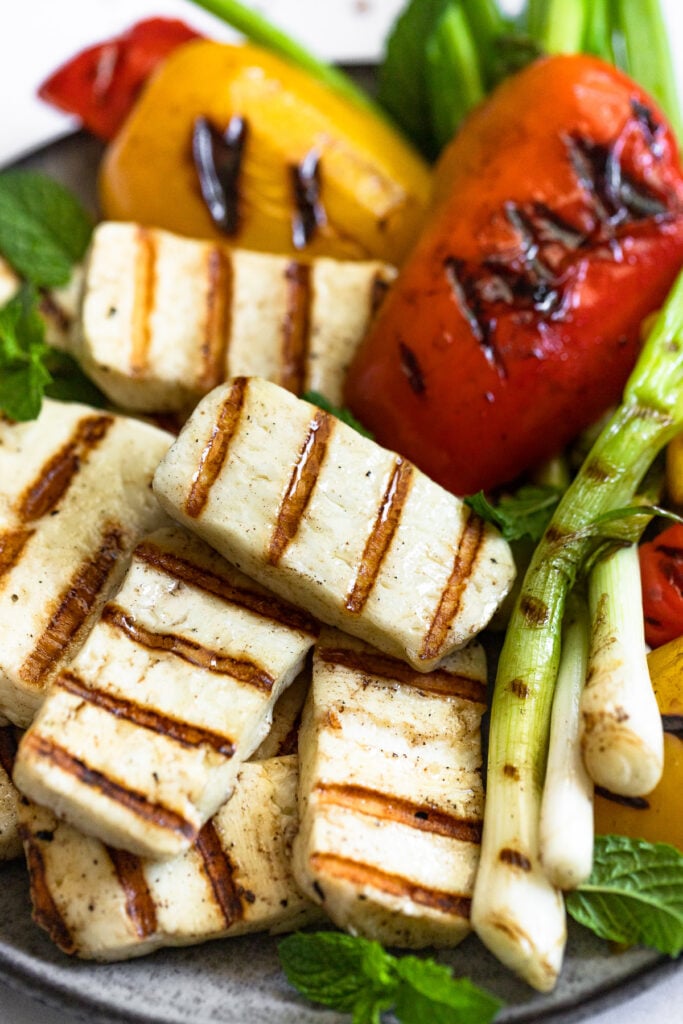
It honestly reminded me a lot of the cheese curds we enjoy in the Midwest, without all the deep-frying that’s involved with them.
It’s been my go-to for summer BBQs, easy sandwiches, and quick lunches. Let’s learn all about it together and dive into the best ways to prepare this delicious, entree-worthy cheese.
Table of Contents
- What is Halloumi?
- What does it taste like?
- Where to Buy Halloumi
- How to Cook Halloumi
- What to Eat with Halloumi Cheese
- Substitutes
- Storage & Reheating
What is Halloumi?
Halloumi is a Cypriot cheese, originating from the island of Cyprus. It’s a semi-soft cheese made from a mixture of goat and sheep’s milk. It can also be made with cow’s milk.
It can vaguely be compared to the texture of mozzarella or a block of feta, but is unique in that it has a high melting point, which makes it perfect for grilling and especially as a meat substitute. When it’s heated, it doesn’t turn into a melty mess of cheese, but rather, it holds its shape beautifully, resulting in the perfectly fry-able cheese!
Halloumi is most often made with vegetarian rennet, making it a wonderful vegetarian cheese option. As always, be sure to check the package of the specific product you use.
It’s also worth noting that halloumi is packaged with mint leaves, often chopped, so if you see little flecks of it throughout the package, it’s just mint. There’s no need to remove it before cooking.
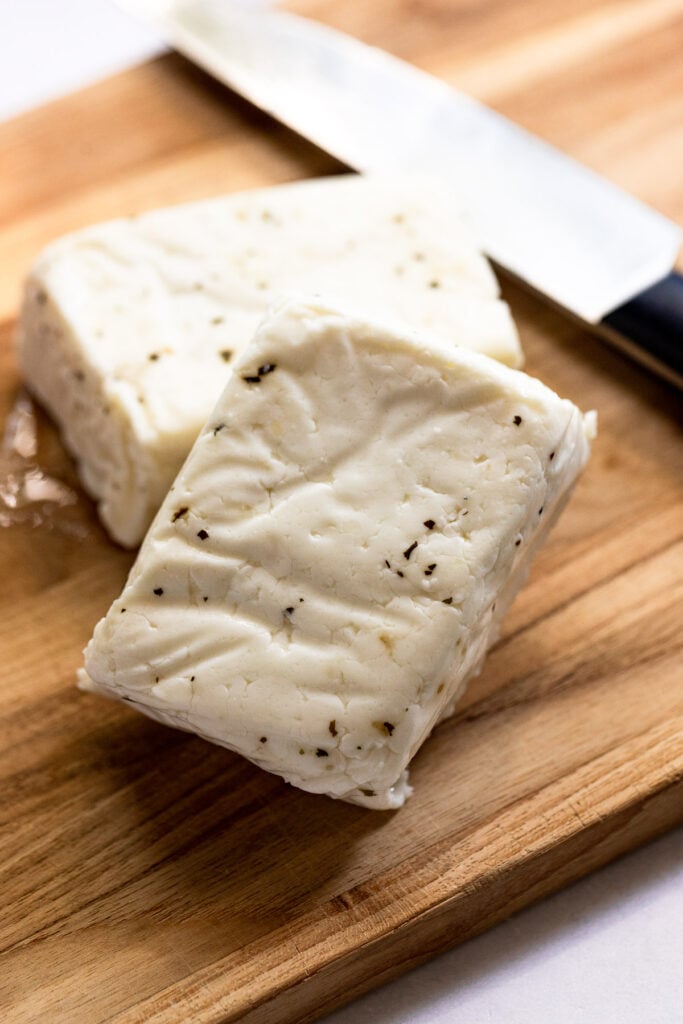
What does it taste like?
If you enjoy the texture and saltiness of cheese curds, you’re gonna love halloumi.
It has a similar squeaky texture, and because it’s packed in brine it’s super salty. When it’s cooked, the saltiness mellows out, and it becomes soft and gooey, with a crisp exterior. It’s not a typical cheesy cheese, it’s simply salty and slightly creamy.
You can eat halloumi raw, but it is much better when enjoyed warm when it turns gooey on the inside.
Where to Buy Halloumi
Here in the Midwest, halloumi has been popping up in grocery stores. I buy mine at ALDI, where it’s pretty reasonably priced. I’d recommend trying Trader Joe’s or Whole Foods, too.
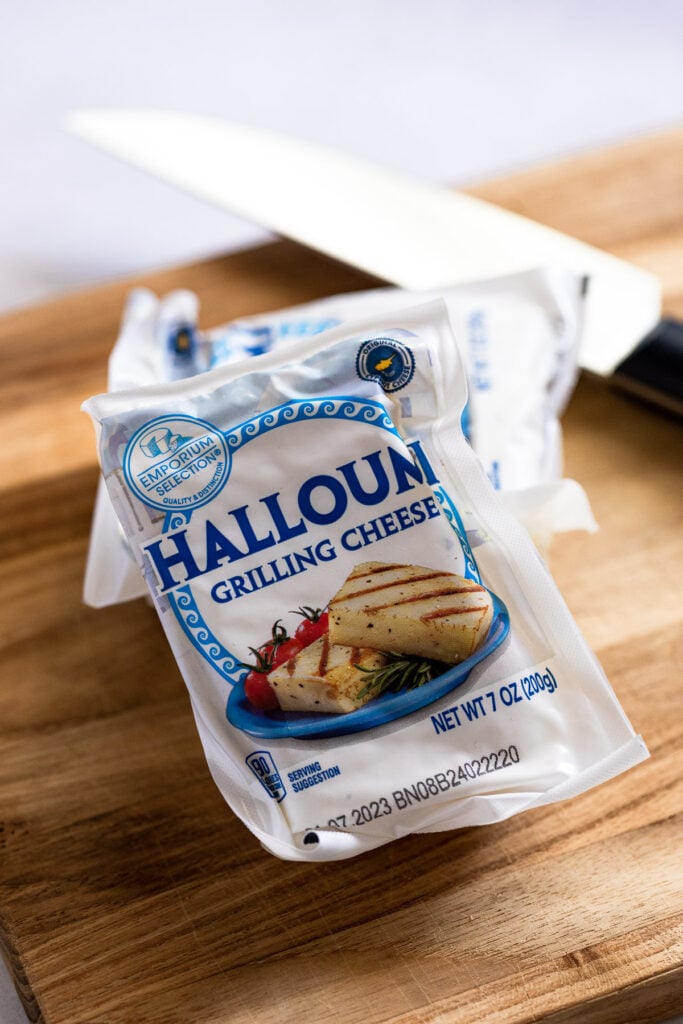
If you aren’t having luck at your local grocery stores, be sure to check out any Mediterranean delis you have nearby, they’ll likely have some for purchase.
How to Cook Halloumi
The two most common ways to cook halloumi are grilling and pan-frying. Both are super simple and have very similar methods. Bonus, each method only takes a few minutes before you have deliciously fried cheese.
It’s best when it’s enjoyed warm, so make sure it’s the last thing you have to prep!
Preparation
Once you remove the halloumi from the package, pat it dry with a paper towel. Similar to when cooking scallops, removing the brine and creating a dry exterior is going to help it crisp up (yes, even though we will be adding oil).
Then, slice the block of cheese into your desired size.
If I’m using the slices on a sandwich, I like to slice the long way so one thick slice will fit on a roll or bread. Slice it on the short in to create more smaller slices, which is great for serving in salads and with grilled veggies. Or, dice it into large cubes for kebabs.
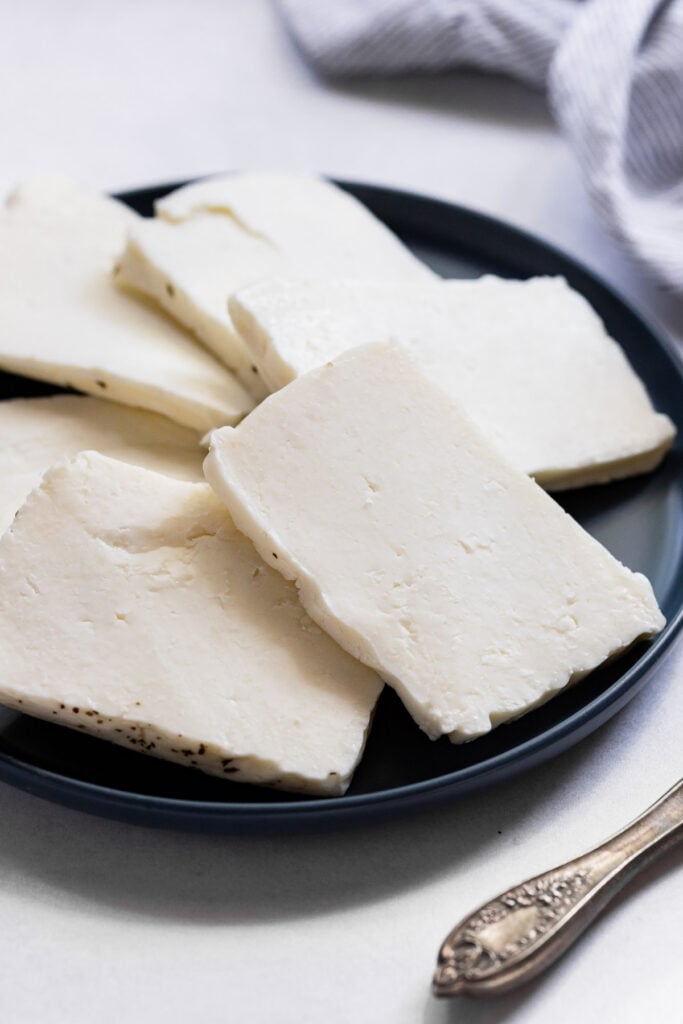
Brush with Oil
It’s really important to brush your slices with oil so that it doesn’t stick to the pan, especially when grilling.
I like to use olive oil, but any neutral oil will work. Make sure it has a somewhat high heat point.
And this is the only time I will say this (probably), there is absolutely no need to salt before you cook!
Halloumi is already salty enough from the brine it is stored in, so salting it before cooking would just way overdo it. Save the salt for the veggies this time!
Grill or Pan-Fry
You can use a grill or a grill pan to grill it up. Otherwise, grab a skillet, I like to use my cast iron for a lovely sear, and pan fry the slices. If you don’t have a well-seasoned cast iron, opt for a non-stick pan. If using stainless steel, you will want to be sure to add extra oil to the pan and turn the heat down a bit.
Heat the pan (or grill) over medium-high heat. If grilling, I also like to brush a little oil on the grates before cooking to doubly ensure it doesn’t stick. Then, place the oiled slices directly on the heated pan and allow it to cook for 2-3 minutes.
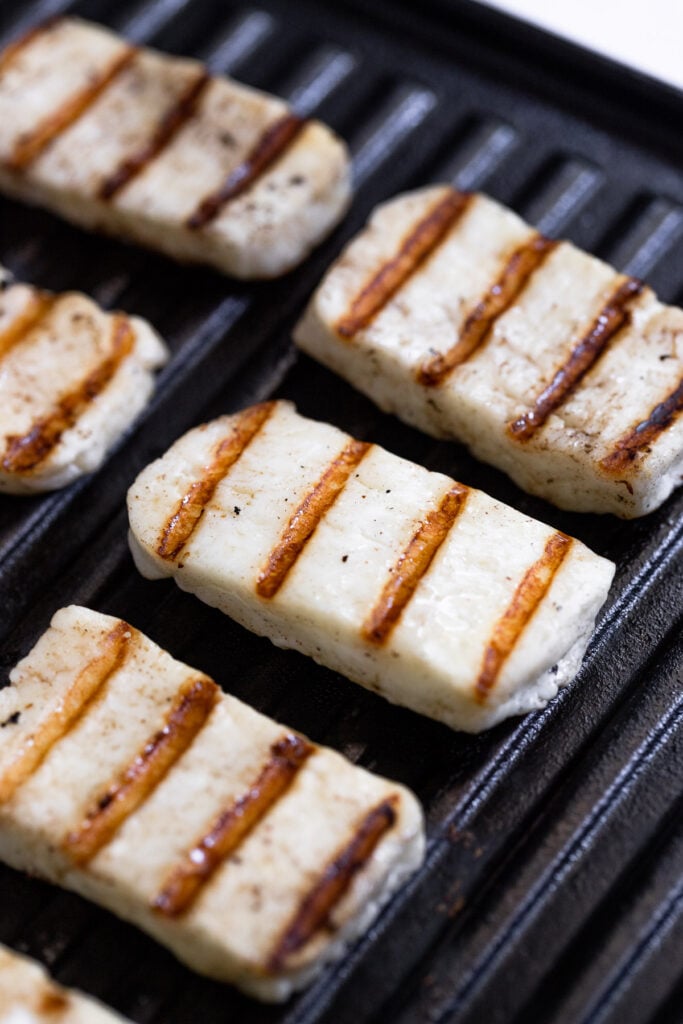
Usually, it will easily flip when it’s crisp and ready to be turned. So give it a little wiggle and if it’s not budging, first make sure it’s not burnt, then give it another 30 seconds or so. Be sure to not overcook it or it will become tough and/or rubbery.
Flip the slices, again cooking until golden brown. Then remove from the pan and serve immediately.
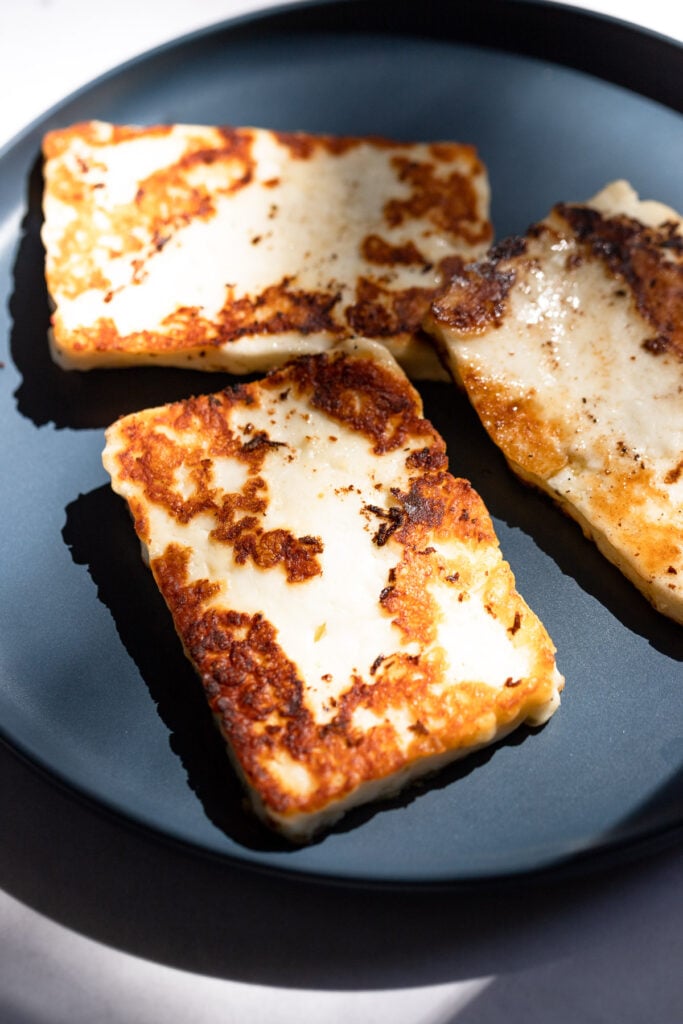
Cooking Tips
- Thicker slices are better; if they are too thin, they are more likely to overcook and become hard.
- Add a little oil to the skillet or grill grates to doubly ensure it won’t stick.
- If it smokes a little, that’s ok! Turn on that microwave fan or open a window. You want the pan hot enough to sear the outside of the cheese.
- The cheese won’t melt but will get soft as it cooks.
- There’s no need to cook it too long though, or it will become too crisp.
What to Eat with Halloumi Cheese
There are so many ways to enjoy halloumi! In Cyprus, it’s enjoyed with watermelon (if you haven’t had a watermelon salad with salty cheese, you must try it!). It’s also great on all sorts of salads. The warm cheese contrasted with cool veggies is delicious.
Serve it with grilled veggies for an easy summer dinner, on a kebab, or roasted veggies in the winter.
It can be added to sandwiches as a meat replacement, or diced and added to a vegetarian kebab.
You’ll also commonly find the fried cheese on mezze platters. Why not add it to vegetarian gyros or veggie tacos?! It’s also super yummy with romesco sauce like in this sandwich recipe.
Substitutes
Because halloumi is such a unique cheese, there aren’t great substitutes for it. There’s not really another cheese with its texture or saltiness.
The closest cheese would be a firm block of feta when it’s raw. However, for a halloumi recipe, I recommend sticking with halloumi.
To substitute halloumi in place of another cheese, cooked halloumi would work in place of mozzarella in some recipes (as long as the saltiness doesn’t clash) and can replace feta in some recipes (like on salads).
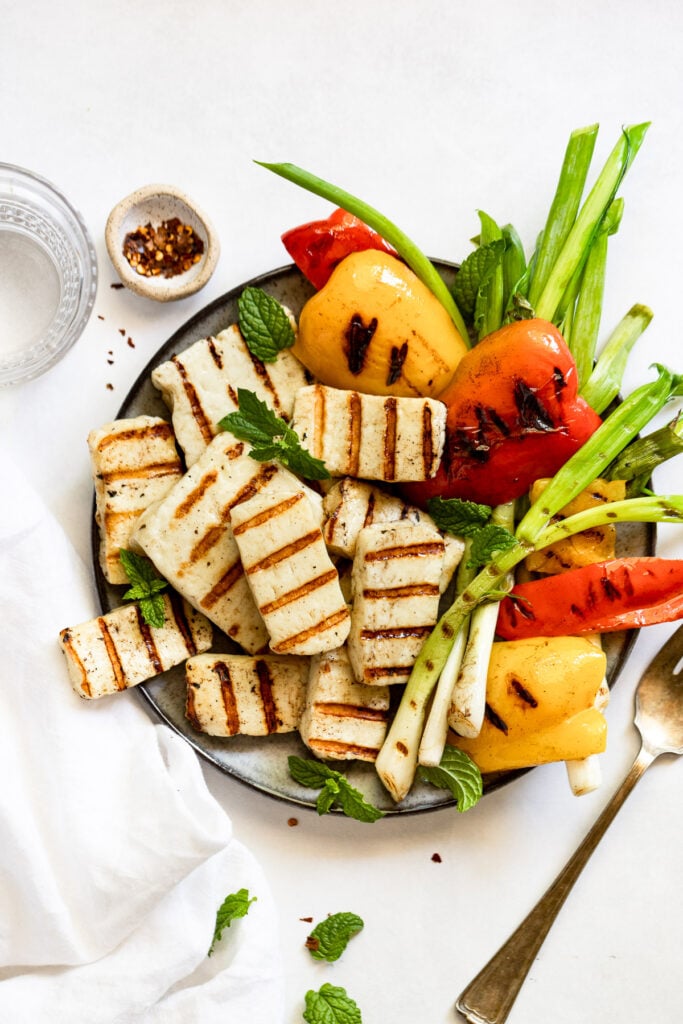
Storage & Reheating
Unopened and in the package with brine, halloumi can last in the fridge for up to a year.
Once it’s opened, if it’s stored in salt water in an airtight container, it can last a week or so, but unwrapped it should be used within a couple of days. I’ve also read that you can freeze halloumi, wrapped well if opened, for 2-3 months without impacting its texture, but I haven’t tried it yet myself.
Reheating
Here’s the thing: it’s not the best reheated. And many people will simply say just don’t do it. But I’m not one of them.
While yes, I totally agree that enjoying halloumi immediately after cooking it is best – both in texture and flavor – I also totally get that sometimes you have leftovers. And you don’t like wasting food!
So again, with the disclaimer that reheated halloumi will not be the same as freshly cooked, you can zap it in the microwave briefly and enjoy it reheated. It will likely be extra squeaky, but still enjoyable. Just don’t over-reheat it; 20-40 seconds in the microwave is really all you’ll need, depending on how much you have to reheat.
Did you make this recipe? Please leave a star rating and review in the form below. I appreciate your feedback, and it helps others, too!
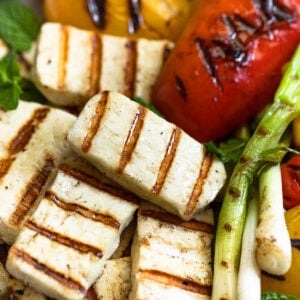
Get the Recipe How to Cook Halloumi Cheese
Ingredients
- 7 ounces halloumi cheese
- 1-2 Tablespoons neutral oil or olive oil
Equipment
Instructions
- Remove the block of halloumi from the package and pat dry with paper towels. Cut the block into slices either lengthwise or on the short end, depending on how you'll use it. I prefer about 1/2-inch slices. You can also dice it into large cubes. Remember, thinner slices will cook faster.
- Brush both sides of the slices with oil until coated. Heat a cast-iron skillet or grill pan (or grill) over medium-high heat. If using a grill pan or grates, I also like to brush oil on the grates.
- Place the slices evenly across the pan. Sear until golden brown, around 1-2 minutes, then flip and sear the second side, again until golden brown, around 1-2 minutes. Some liquid may sizzle out of the slices; it will quickly evaporate and then the side will turn golden.
- Remove from the pan and serve immediately. Excellent garnished with a squeeze of fresh lemon juice, herbs, and black pepper. Remember, there is no need for salt as this cheese is already quite salty.
Notes
- The size of your halloumi block may vary, depending on where you purchase it. The cooking instructions are the same either way and cook time will depend on how thick you slice it.

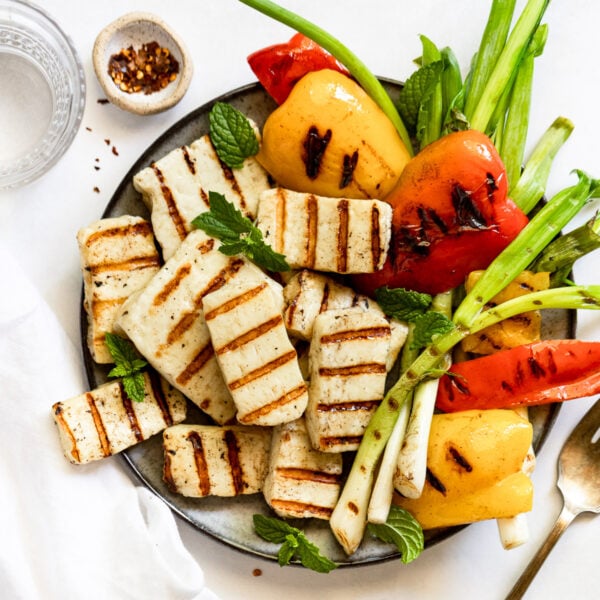




thank you for the informative article.
I enjoyed your writing.
Thanks, David!
thank you for the informative article.
I enjoyed your writing.
The halloumi I purchased at Costco was produced in Cyprus with non animal rennet so that is a big +
Another great find at Costco – awesome! Thanks for sharing!!
How nice to find such an in-depth article. I had seen halloumi mentioned in a magazine, didn’t know what it was, looked it up and found this. Looking back, I’m sure this is what my son-in-law made as an appetizer for Mother’s Day and what I found very interesting without knowing exactly what it was. I now know and we do have an Aldi nearby so will be on the lookout. Thanks for enlightening me.
I’m so happy you found it helpful! Thanks, Pat!
Thank you for the article!!! To add one information: there is one cheese with the same flavor and texture in Brazil called queijo coalho (curd cheese). It grills the same way with the same texture and the flavor is super close although queijo coalho is made of cows milk.
Thank you so much for sharing, Moises!